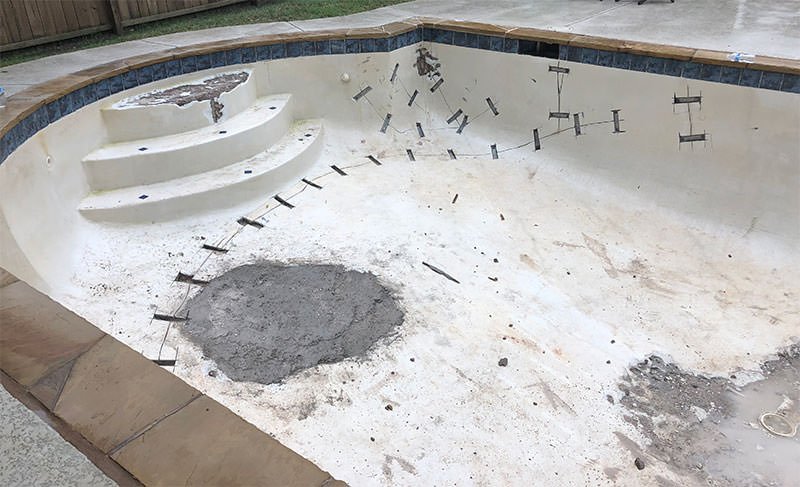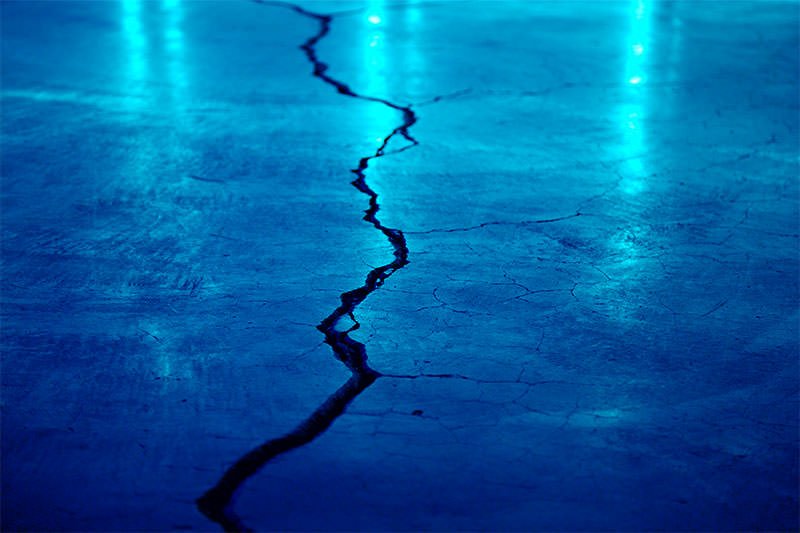Local DFW Leak Detection Experts
The water you fill your swimming pool with on day one won’t be the same water that’s in the pool on day 100. Pools naturally lose and gain water throughout the year.
They take in water when it rains and lose water because of evaporation. In many cases, people using the pool can lead to water loss — some water gets splashed up onto the deck or surrounding grass.
But swimming pools can also develop leaks, for many reasons. In some cases, the leak is within the pool itself and can be fixed with pool resurfacing or replastering.
In other, much more rare instances, the leak is in the pool’s plumbing, requiring a much more extensive fix.
Determining if your pool is leaking and where it is leaking from will help you decide which pool leak repair option is most appropriate for you.
Inground Pool Leak Detection: Signs That There’s a Leak
Swimming pool leaks can be pretty expensive. Depending on how quickly your pool is losing water, it can be pricey to regularly refill the pool to replace the water. Spotting a leak isn’t too complicated, as long as you know what to look for.
Here are a few common signs that your pool is leaking:
- You have to refill it often (weekly, if not more).
- The water level drops by more than 1/4 inch per day (or more than two inches per week).
- You can see cracks in the pool or near the decking.
- The ground around the pool is continuously wet, even if no one is using it. If there’s grass, it is wet enough to be soggy.
- The decking around the pool starts to shift or sink.
- The pool tiles are cracked or otherwise damaged.
How to Find a Leak in Your Pool
Noticing that your pool is losing water is just the first step in pool leak detection. The next thing to do is figure out where the leak is coming from.
Determining the source of the leak can be something you do before your call up a team of professionals. Once you know why and where your pool is leaking, you’ll be better equipped to repair the leak.
Determine if the Pool Is Losing Water When Pump Is On or Off
The type of leak will often influence when the pool loses water.
For example, if the pool is losing water when the pump is off, that usually means that there is an issue with the pipes that provide the pool with water.
One way to see if the pool loses water when the pump is off is to turn the pump on.
Switching on the pump will create a vacuum with the pipes that bring water into the pool, reducing or eliminating any leaks. If the leak is happening in what is known as the suction side pipes, you’re likely to see air bubbles in the pump basket or return lines. There is also likely to be air filling up the filter tank.
If the pool loses water when the pump is on, it’s likely that the problem is with the pressure-side pipes.
Signs of a leak when the pump is switched on include wet areas in your yard, usually on the side where the pipes that return the water to the pool are located. You might also see water running from the waste line regularly.
Determine if the Pool is Losing Water All of the Time
While a pool that leaks when the pump is on or off usually has a leak in the plumbing, a pool that leaks continually is likely to have an issue elsewhere.
If your pool seems to be losing water 24/7, it could be due to cracks in the tile or plaster. If the pool is lined with vinyl, there might be a tear in the vinyl.
Often, the source of the leak is the plastic skimmer in the pool. It’s relatively common for a separation to develop between the pool’s concrete and the plastic skimmer.
Another common source of a pool leak, which causes water loss all of the team, is a gap or opening around the pool’s lights.
Swimming Pool Leak Detectors and Tests
If you suspect a leak in your swimming pool, there are a few ways to detect and test.
In some cases, swimming pool leak detectors will merely confirm that yes, you are losing water at a rate that exceeds normal evaporation. In other cases, the tests will give you an idea of where the leak is occurring.
Often, these tests are easy enough to do on your own. If they detect a leak, the next step is to call in a professional pool leak detection service to verify the leak and confirm its source.
Bucket Test
A bucket test will let you know if your pool is losing water naturally, as a result of evaporation or if there is a more significant leak.
To perform the bucket test:
- Place a 5-gallon bucket on the second step of your pool. Fill the bucket so that the water level in it is even with the water level in your pool. You might need to put a rock or something heavy in the bottom of the bucket to weigh it down. Also, keep in mind that the edge of the bucket shouldn’t be underwater.
- Cut two 1-inch pieces of electrical tape. Place one piece on the inside of the bucket, lined up with the water’s level. Place the second piece on the exterior of the bucket, even with the pool’s water level.
- Turn the water pump off.
- Come back after 24 hours and compare the water levels. If the water inside the bucket and in the pool has decreased by the same amount, you most likely don’t have a leak. Any water lost is most likely a result of evaporation. But if the water level in the pool is considerably lower than the water inside the bucket, it’s likely that there is a leak.
You can also perform the bucket test with the pump on, to see if that is causing the leak. Merely repeat the test but switch the pool’s pump on for the 24-hour period.
Ink or Dye Test
The ink or dye test can help you detect the source of a pool’s leak, such as a crack in the concrete or tear in the vinyl.
The test only really works if you have a general idea of where the leak is coming from. It’s also only effective if the leak is from the pool itself, rather than in the plumbing.
To perform the test, find a bottle of food coloring or other non-toxic dye. Choose a color that will be easy to spot in the water (such as red). Move towards the area where you think the leak is, then squirt a bit of the dye into the pool’s water. If there’s a crack or tear that’s causing the leak, the dye will quickly move towards it.
Another way to test for a pool leak and detect the location of a leak is just to let the pool drain.
If there’s a leak somewhere on the wall of the pool, it will stop losing water once the level of the pool is below the location of the crack or tear.
A disadvantage of the drainage test is that you might have to empty your pool entirely or nearly entirely if the leak is near the bottom of the wall or on the floor of the pool.
Note: You should never leave your pool completely empty without water for extended periods of time.
Professional Leak Detection Service
If you suspect that your pool is leaking, one of the best things you can do is call in a pool leak detection service. A team of professionals will visit your home and conduct tests to determine the source of the leak and to recommend the best course of action.
If you are going to hire a team to perform leak detection in your pool, it’s a good idea to prepare your pool for the inspection. Remove any debris from the water, such as leaves or grass clippings, before the team arrives.
It’s also a good idea to make sure your pool’s water is as clear and clean as it can be. The cleaner the water, the easier it is to spot leaks. Plus, clear water is healthier for your family and for anyone who uses the pool.
Pool Leak Repair
If there is a leak, the next step is to repair the pool to stop further water loss. How extensive and expensive the pool leak repair is will depend on the source of the leak.
If the plumbing’s involved, you might need to have some of your yard dug up. But if the leak is within the pool itself, your yard can stay intact.
Detecting and repairing a pool leak might seem like a hassle.
But it’s better to fix the problem than it is to ignore it and continue to deal with the maintenance and expense of refilling a draining pool.
Pool Leak Professionals
If you need help determining if you have a leak in your pool or need a professional to fix a leak, the team at Willsha Pools can help today.
Give us a call at (817) 406-2269 or use the form on the contact page.


